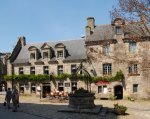THE STORY OF THE catharS
The story of the Cathars, the search for the Holy Grail, the secrets of clandestine 'brotherhoods', is the stuff of legend, books, films – and even court cases. And legends are good stories that withstand the re-telling, over and over again. Whether you're a fan of Dan Brown (The Da Vinci Code) or Kate Mosse (Labyrinth) there is no escaping the fact that the mysteries and horrors that surround one of the most brutal periods in French history are well and truly in vogue.
A year or so ago, I took a nine-day walking trip to the south of France, into the Midi-Pyrenees and Languedoc-Roussillon, to explore the country of the Cathars. What I found was fascinating, and sent me down a trail of research that continues still, making frequent return visits to this physically convoluted region. The Da Vinci Code spends most of its time in and around Paris, but its topic, that of religious conflict and persecution, spreads its tentacles throughout France, and, in the Midi, finds a touchstone in the history of the Cathars. Ironically, the persecution of the sect overshadows the beauties of the civilisation among whom they lived, in particular the Occitan way of life, language and the songs of the troubadours. The so-called 'crusade' effectively wiped out the Occitan way of life, and the beautiful regional language, the langue d'oc. For that, Europe is all the poorer, having forfeited one of the most exquisite cultural opportunities since the times of Ancient Greece.
THE STORY OF THE CATHARS
The 'country of the Cathars', le
Pay Cathare, is widespread and spans more than one département, indeed, more than one region, reaching from Toulouse
in the west to Carcassonne and Béziers in the east, and extending as far north
as the town of Albi in Tarn. In fact, the war that was to be waged against the
Cathars came to be known as the Albigensian Crusade.
Catharism was a religious movement originating around the middle of the 10th century, and branded by the contemporary Roman Catholic Church as heretical. It existed throughout much of Western Europe, but its home was in Languedoc and surrounding areas in southern France. The name Cathar most likely originated from Greek καθαροί, meaning "pure ones". Cathar society was divided into two general categories, the Perfecti (Perfects, Parfaits) and the Credentes (Believers). The Perfecti were the core of the movement, though the actual number of Perfecti in Cathar society was always relatively small, numbering at most a few thousand during any given period. While the Perfecti lived lives of simplicity, frugality and purity, Cathar credentes (believers) were not expected to adopt the same stringent lifestyle. Catharism was above all a popular religion and the numbers of those who considered themselves believers in the late twelfth century included a sizable portion of the population of Languedoc, counting among them many noble families and courts.
In short, the Cathars represented a break-away religion from the Catholic church of Rome, and its success and popularity aroused the anger of Rome. The result was a crusade, but a crusade with a deadly mission, to exterminate the Cathars and all their believers. The resulting war of religion was long and unrelenting, enlisting the aid of some of the most powerful nobles in France. The army of crusaders, known as the ost was vast and powerful, and commanded by men of passion. Their most ignoble and inglorious moment came in 1209, as they lay siege to the city of Béziers, perched above the Orb river. Folly on the part of some inhabitants led to soldiers of the Crusade entering the city, wreaking havoc. But faced with hesitation on the part of some crusaders to commit the horrific acts that were being performed in the name of the church, Arnaud-Amaury, abbot of Cîteaux and spiritual leader of the Crusade is reported to have instructed 'Kill them all! God will know his own.' Béziers was razed, and the army moved on to Carcassonne, which, with more time in which to prepare, was not so readily defeated. But one man stood out, one man who took up the Crusade and defeated all who stood in his way. Simon de Montfort, from the Île de France, had the task of subduing the lands of the Midi, which he did with relentless efficiency until in 1218, a strategically placed mangonel on the ramparts of Toulouse, operated, it is said, by women and girls, fired a rock which hit de Montfort's head, shattering his brain, eyes, teeth, forehead and jaw. Not surprisingly, the troubadours of Toulouse were not slow to compose 'Long live Toulouse, glorious and powerful city, Noblesse and honour have returned, Montfort is dead.'
It is not known how many Cathars and their followers died. Some put the estimate at well over a million. And though the sect is believed to have been exterminated, there is evidence that today it still exists.
Recent Articles
-
French Food and Drink - No BS Guide for lovers of Food, Wine, Liqueurs
Aug 28, 19 03:18 AM
Our guide to French food and drink for those who love traditional French food along with our no BS guide to understanding French wine and liqueurs
-
Things To Do In Carcassonne The Ultimate Tourist Guide
Aug 24, 19 06:26 PM
The ultimate tourist guide to things to do in Carcassonne when you visit this wonderful town in Aude France. Discover the places to go and see in Carcassone.
-
Lyon Old Town Guide to Vieux Lyon
Aug 18, 19 07:48 AM
Your complete guide to Lyon old town otherwise known as the Vieux Lyon. Don't miss this amazing part of the city if you're visiting Lyon in France.
-
18 French Villages You Must Visit Most Beautiful Villages in France
Aug 17, 19 06:31 AM
Our guide to the 18 most beautiful French villages you simply must visit. Loads of info, photos and facts in our ultimate villages in France tourist guide
-
What a Pissoir - The True Story of France's Unique Urinals
Aug 13, 19 03:47 PM
Is there anything more French than a pissoir? Sadly on the decline nevertheless the pissor is an endring image of the country. This is their story





